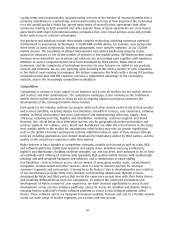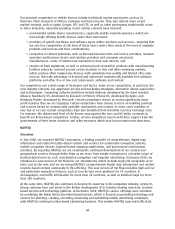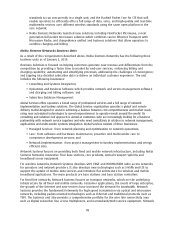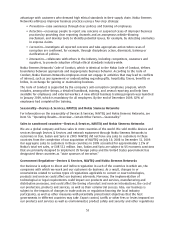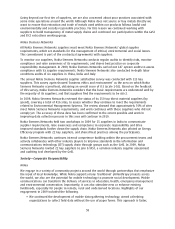Nokia 2009 Annual Report Download - page 55
Download and view the complete annual report
Please find page 55 of the 2009 Nokia annual report below. You can navigate through the pages in the report by either clicking on the pages listed below, or by using the keyword search tool below to find specific information within the annual report.advantage with customers who demand high ethical standards in their supply chain. Nokia Siemens
Networks addresses improper business practices using a fourstep strategy:
•
Prevention
—raise awareness through clear policies and training of employees.
•
Detection
—encourage people to report any concerns or suspected cases of improper business
practices by providing clear reporting channels and an anonymous whistleblowing
mechanism, and develop tools to identify potential issues, for example, by detecting anomalies
in expense claims.
•
Correction
—investigate all reported concerns and take appropriate action when cases of
corruption are confirmed, for example, through disciplinary action, dismissals, training or
clarification of policies.
•
Interaction
—collaborate with others in the industry, including competitors, customers and
suppliers, to promote adoption of high ethical standards industrywide.
Nokia Siemens Networks’ Code of Conduct, which is identical to the Nokia Code of Conduct, defines
boundaries between appropriate and inappropriate business behavior. According to the Code of
Conduct, Nokia Siemens Networks employees must not engage in activities that may lead to conflicts
of interest, such as any agreement or understanding regarding gifts, hospitality, favors, benefits or
bribes, in exchange for gaining or maintaining business.
The Code of Conduct is supported by the company’s anticorruption compliance program, which
includes, among other things, a detailed handbook, training, and several reporting and help lines
available for employees and external workers. A new ethical business training program was launched
in January 2009, which is mandatory for all employees. By the end of December 2009, 82% of
employees had completed the training.
Seasonality—Devices & Services, NAVTEQ and Nokia Siemens Networks
For information on the seasonality of Devices & Services, NAVTEQ and Nokia Siemens Networks, see
Item 5A. “Operating Results—Overview—Certain Other Factors—Seasonality.”
Sales in sanctioned countries—Devices & Services, NAVTEQ and Nokia Siemens Networks
We are a global company and have sales in most countries of the world. We sold mobile devices and
services through Devices & Services and network equipment through Nokia Siemens Networks to
customers in Iran, Sudan and Syria in 2009. NAVTEQ did not have any sales to customers in these
countries from the completion of our acquisition of NAVTEQ on July 10, 2008 to December 31, 2009.
Our aggregate sales to customers in these countries in 2009 accounted for approximately 1.2% of
Nokia’s total net sales, or EUR 511 million. Iran, Sudan and Syria are subject to US economic sanctions
that are primarily designed to implement US foreign policy and the United States government has
designated these countries as “state sponsors of terrorism.”
Government Regulation—Devices & Services, NAVTEQ and Nokia Siemens Networks
Our business is subject to direct and indirect regulation in each of the countries in which we, the
companies with which we work and our customers do business. As a result, changes in or
uncertainties related to various types of regulations applicable to current or new technologies,
products and services could affect our business adversely. Moreover, the implementation of
technological or legal requirements could impact our products and services, manufacturing and
distribution processes, and could affect the timing of product and services introductions, the cost of
our production, products and services, as well as their commercial success. Also, our business is
subject to the impacts of changes in trade policies or regulation favoring the local industry
participants, as well as other measures with potentially protectionist objectives that the host
governments in different countries may take. Export control, tariffs or other fees or levies imposed on
our products and services as well as environmental, product safety and security and other regulations
53


